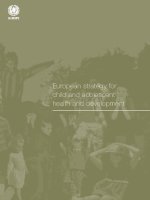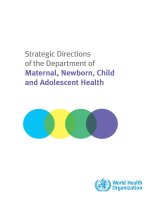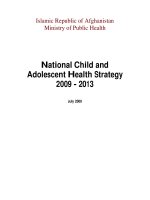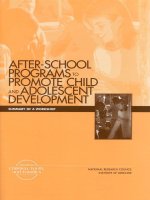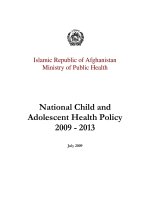child and adolescent counseling chapter 15
Bạn đang xem bản rút gọn của tài liệu. Xem và tải ngay bản đầy đủ của tài liệu tại đây (149.41 KB, 55 trang )
Chapter 15
Family Counseling
Life is interrelated. We are caught in an inescapable
network of mutuality; tied in the single garment of
destiny. Whatever affects one directly, affects all
indirectly.
Martin Luther King, Jr.
© 2011 Brooks/Cole, A
Chapter Objectives
After reading this chapter, you should be able to :
•Outline the development of family counseling
•Explain system’s focus on family relationships
•Discuss the counseling relationship and goals
•Describe the differences between healthy and unhealthy
systems
•Discuss some therapeutic techniques in family counseling
•Outline family counseling approaches to play therapy
•Clarify the effectiveness of family counseling
© 2011 Brooks/Cole, A
Defining Historical Event
• In the 1950s a number of researchers who were working
independently began to look at schizophrenia as an area
where family influences might be connected to the
development of psychotic symptoms.
• Those efforts of Bateson’s Palo Alto, California, group,
Lidz’s project at Yale, and Bowen and Wynn at the Institute
of Mental Health led to research discoveries of the
therapeutic value of seeing family members together
© 2011 Brooks/Cole, A
What makes it different?
• Focus on family and its members’
interactions and relations
• Involves interventions to alter the
entire family system
• Problem diagnosis is circular causality,
roles each person plays in maintaining
problem
© 2011 Brooks/Cole, A
What defines a family?
Webster’s Dictionary definitions:
• Group of people who are (1) bound by
philosophical, religious, or other convictions,
(2) common ancestry, and (3) living under
the same roof. And
• Basic biosocial unit in society having as its
nucleus two or more adults living together
and cooperating in the care and rearing of
their own or adopted children
© 2011 Brooks/Cole, A
Systems Theory and Families
• System = organized unit made up of
interdependent parts
• Whole unit is greater than the sum of its
parts
• Change in any part affects all other parts
• Family is system in which each member
has a significant influence on all other
members
© 2011 Brooks/Cole, A
Systems Theory and Families
Families may struggle to find a healthy
balance between two extremes:
• Enmeshment = over involvement in
each others’ lives
• Disengagement = too much
detachment from one another
© 2011 Brooks/Cole, A
Core Concepts
•Centripetal and Centrifugal.
•Cybernetics.
•Family
•Dyad.
•Marital dyad.
•Nuclear family.
© 2011 Brooks/Cole, A
Core Concepts
• Holon
• Family boundaries
• Family homeostasis
• Family projection process
• Family system
© 2011 Brooks/Cole, A
Core Concepts
•
•
•
•
Family therapist
Family therapy
Feedback loop
Triangulation
© 2011 Brooks/Cole, A
Core Concepts
Goldenberg and Goldenberg (2008) included some other
fundamental concepts:
•Family rules. Prescribed rules for the boundaries of permissible
behavior. The rules may not be verbalized but are understood by all
family members; the rules regulate and help stabilize the family
system.
•Family narratives and assumptions. Beliefs about the world
shared by the family members. Some see the world as a friendly,
orderly, predictable place in which they can function competently.
Others see the world as threatening, unstable, and unpredictable,
therefore, as dangerous. The family story links certain experiences
into a sequence that justifies how and why they live as they do.
© 2011 Brooks/Cole, A
Core Concepts
Goldenberg and Goldenberg (2008) continued:
•Pseudomutuality and pseudohostility. The façade of
togetherness that masks underlying conflict and the collusion of
quarreling that is a superficial tactic for avoiding deeper issues.
•Mystification. An effort to obscure the real nature of family
conflict by distorting experiences; contradicts one person’s
perceptions and, after repeated experiences, leads the person to
question reality.
•Scapegoating. Redirecting conflict by holding one person
responsible for whatever goes wrong (pp. 415-417).
© 2011 Brooks/Cole, A
Other Fundamental Concepts
• Family rules.
• Family narratives and assumptions.
• Pseudomutuality and pseudohostility. .
• Mystification.
• Scapegoating.
© 2011 Brooks/Cole, A
Systems Approach to Family
Therapy: Murray Bowen
• Focuses on how family members
could maintain a healthy balance
between being enmeshed and being
disengaged.
• Believes each member should have an
individual identity, while maintaining
closeness with family.
© 2011 Brooks/Cole, A
Murray Bowen
• Spousal Relationship
o
Are they able to differentiate themselves as
individuals apart from the couple?
• Differentiation of Self
o
ability to separate thoughts from feelings
o
struggle to develop identity and remain part
of the family
© 2011 Brooks/Cole, A
Murray Bowen
• Differentiation of Self
o
Highly differentiated = better at handling
stress/anxiety
o
Increased differentiation by one family
member is likely to lead other members to
become more differentiated
• Self-differentiation is principal goal of
family therapy
© 2011 Brooks/Cole, A
Murray Bowen
• De-triangulation of Self from Family
Emotional System
o
Triangulation refers to the practice of two
family members bringing a third into their
conflict
• Nuclear Family Emotional Process
1. Emotional distance
2. Problem transference
3. Blamers
© 2011 Brooks/Cole, A
Murray Bowen
• Family Projection Process
o how
parents pass good and bad things
onto their children
• Multigenerational Transmission
Process
o how
family passes baggage from one
generation to the next
© 2011 Brooks/Cole, A
Murray Bowen
• Sibling Position
o
birth order to extreme = dysfunction
o
problems when same birth order marry?
• Emotional Process in Society
o
genogram = generational map of family
o
examples: marriage, birth, death, education,
work life, SES, ethnic origins, politics,
religion, relationships, etc.
© 2011 Brooks/Cole, A
Murray Bowen
• Emotional Systems of the Family
o
Understanding the emotional system and
how they work central to the theory
o
Again achieving differentiation primary
• Modeling Differentiation
o
Using “I” statements and taking ownership
of his own thoughts, feelings, and behaviors
© 2011 Brooks/Cole, A
Structural Family Therapy
• Goal: to alter family structure and
empower dysfunctional family to move
towards functional family
communications
• Functional families characterized by
each member’s success in finding the
healthy balance between belonging to
a family and maintaining a separate
identity
© 2011 Brooks/Cole, A
Structural Family Therapy
• One way to find balance between family and
individual identity is to define and clarify the
boundaries between the subsystems
• Boundaries range from rigid to diffuse
• Secret is in finding the right boundary balance
that is well defined
• Structural family therapy directed toward
changing the family organizational structure
© 2011 Brooks/Cole, A
Salvador Minuchin
• founder of structural family therapy
• learned from observations of families
• wrote Families of the Slums (1967)
© 2011 Brooks/Cole, A
Salvador Minuchin
• Transformed Philadelphia Guidance Clinic
into a model family therapy center
• With Jay Haley developed the Institute for
Family Counseling, designed to train
paraprofessionals
• Structural family therapy = a zoom lens that
can focus on the entire family or a close-up
of any family member
© 2011 Brooks/Cole, A
Salvador Minuchin
Boundaries involve
• who participates
• areas of responsibility
• decision making
• privacy
© 2011 Brooks/Cole, A

